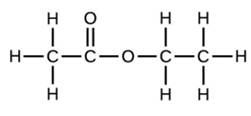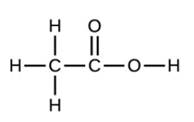
Chemistry: Atoms First
18th Edition
ISBN: 9781938168154
Author: Richard Langley, Klaus Theopold, Paul Flowers
Publisher: OpenStax College
expand_more
expand_more
format_list_bulleted
Concept explainers
Textbook Question
Chapter 2, Problem 33E
Write the empirical formulas for the following compounds:

Expert Solution & Answer
Trending nowThis is a popular solution!

Students have asked these similar questions
b) Certain cyclic compounds are known to be conformationally similar to carbohydrates, although they are not
themselves carbohydrates. One example is Compound C shown below, which could be imagined as adopting
four possible conformations. In reality, however, only one of these is particularly stable. Circle the conformation
you expect to be the most stable, and provide an explanation to justify your choice. For your explanation to be
both convincing and correct, it must contain not only words, but also "cartoon" orbital drawings contrasting the
four structures.
Compound C
Possible conformations (circle one):
Дет
Lab Data
The distance entered is out of the expected range.
Check your calculations and conversion factors.
Verify your distance. Will the gas cloud be closer to the cotton ball with HCI or NH3?
Did you report your data to the correct number of significant figures?
- X
Experimental Set-up
HCI-NH3
NH3-HCI
Longer Tube
Time elapsed (min)
5 (exact)
5 (exact)
Distance between cotton balls (cm)
24.30
24.40
Distance to cloud (cm)
9.70
14.16
Distance traveled by HCI (cm)
9.70
9.80
Distance traveled by NH3 (cm)
14.60
14.50
Diffusion rate of HCI (cm/hr)
116
118
Diffusion rate of NH3 (cm/hr)
175.2
175.2
How to measure distance and calculate rate
For the titration of a divalent metal ion (M2+) with EDTA, the stoichiometry of the reaction is typically:
1:1 (one mole of EDTA per mole of metal ion)
2:1 (two moles of EDTA per mole of metal ion)
1:2 (one mole of EDTA per two moles of metal ion)
None of the above
Chapter 2 Solutions
Chemistry: Atoms First
Ch. 2 - In the following drawing, the green spheres...Ch. 2 - Which postulate of Dalton’s theory is consistent...Ch. 2 - Identify the postulate of Dalton’s theory that is...Ch. 2 - Samples of compound X, Y, and Z are analyzed, with...Ch. 2 - The existence of isotopes violates one of the...Ch. 2 - How are electrons and protons similar? How are...Ch. 2 - How are protons and neutrons similar? How are they...Ch. 2 - Predict and test the behavior of a particles fired...Ch. 2 - Predict and test the behavior of a particles fired...Ch. 2 - In what way are isotopes of a given element always...
Ch. 2 - Write the symbol for each of the following ions:...Ch. 2 - Write the symbol for each of the following ions:...Ch. 2 - Open the Build an Atom simulation...Ch. 2 - Open the Build an Atom simulation...Ch. 2 - Open the Build an Atom simulation...Ch. 2 - Determine the number of protons, neutrons, and...Ch. 2 - The following are properties of isotopes of two...Ch. 2 - Give the number of protons, electrons, and...Ch. 2 - Give the number of protons, electrons, and...Ch. 2 - Click on the site...Ch. 2 - Click on the site...Ch. 2 - An element has the following natural abundances...Ch. 2 - Average atomic masses listed by JUPAC are based on...Ch. 2 - Variations in average atomic mass may be observed...Ch. 2 - The average atomic masses of some elements may...Ch. 2 - The 18O:16O abundance ratio in some meteorites is...Ch. 2 - Explain why the symbol for an atom of the element...Ch. 2 - Explain why the symbol for the element sulfur and...Ch. 2 - Write the molecular and empirical formulas of the...Ch. 2 - Write the molecular and empirical formulas of the...Ch. 2 - Determine the empirical formulas for the following...Ch. 2 - Determine the empirical formulas for the following...Ch. 2 - Write the empirical formulas for the following...Ch. 2 - Open the Build a Molecule simulation...Ch. 2 - Use the Build a Molecule simulation...Ch. 2 - Use the Build a Molecule simulation...Ch. 2 - Write a sentence that describes how to determine...Ch. 2 - Compare 1 mole of H2, 1 mole of o2, and 1 mole of...Ch. 2 - Which contains the greatest mass of oxygen: 0.75...Ch. 2 - Which contains the greatest number of moles of...Ch. 2 - How are the molecular mass and the molar mass of a...Ch. 2 - Calculate the molar mass of each of the following...Ch. 2 - Calculate the molar mass of each of the following:...Ch. 2 - Calculate the empirical or molecular formula mass...Ch. 2 - Calculate the molar mass of each of the following:...Ch. 2 - Determine the number of moles of compound and the...Ch. 2 - Determine the mass of each of the following: (a)...Ch. 2 - Determine the number of moles of the compound and...Ch. 2 - Determine the mass of each of the following: (a)...Ch. 2 - The approximate minimum daily dietary requirement...Ch. 2 - Determine the mass in grams of each of the...Ch. 2 - A 55-kg woman has 7.5103 mol of hemoglobin (...Ch. 2 - Determine the number of atoms and the mass of...Ch. 2 - Determine which of the following contains the...Ch. 2 - Determine which of the following contains the...Ch. 2 - Diamond is one form of elemental carbon. An...Ch. 2 - The Cullinan diamond was the largest natural...Ch. 2 - One 53-gram serving of a particular cereal...Ch. 2 - A certain nut crunch cereal contains 11.0 grams of...Ch. 2 - A tube of toothpaste contains 0.76 g of sodium...Ch. 2 - Which of the following represents the least number...
Additional Science Textbook Solutions
Find more solutions based on key concepts
How is a mailing address analogous to biologys hierarchical classification system?
Campbell Biology in Focus (2nd Edition)
Fibrous connective tissue consists of ground substance and fibers that provide strength, support, and flexibili...
Human Biology: Concepts and Current Issues (8th Edition)
1. Why is the quantum-mechanical model of the atom important for understanding chemistry?
Chemistry: Structure and Properties (2nd Edition)
19. Feather color in parakeets is produced by the blending of pigments produced from two biosynthetic pathways ...
Genetic Analysis: An Integrated Approach (3rd Edition)
Answer the following questions for each compound: a. How many signals are in its 13C NMR spectrum? b. Which sig...
Organic Chemistry (8th Edition)
15. A good scientific hypothesis is based on existing evidence and leads to testable predictions. What hypothes...
Campbell Biology: Concepts & Connections (9th Edition)
Knowledge Booster
Learn more about
Need a deep-dive on the concept behind this application? Look no further. Learn more about this topic, chemistry and related others by exploring similar questions and additional content below.Similar questions
- Please help me solve this reaction.arrow_forwardIndicate the products obtained by mixing 2,2-dimethylpropanal with acetaldehyde and sodium ethoxide in ethanol.arrow_forwardSynthesize 2-Ethyl-3-methyloxirane from dimethyl(propyl)sulfonium iodide using the necessary organic or inorganic reagents. Draw the structures of the compounds.arrow_forward
- Synthesize 2-Hydroxy-2-phenylacetonitrile from phenylmethanol using the necessary organic or inorganic reagents. Draw the structures of the compounds.arrow_forwardSynthesize N-Methylcyclohexylamine from cyclohexanol using the necessary organic or inorganic reagents. Draw the structures of the compounds.arrow_forwardSynthesize N-Methylcyclohexylamine from cyclohexanol using the necessary organic or inorganic reagents. Draw the structures of the compounds.arrow_forward
- If possible, please provide the formula of the compound 3,3-dimethylbut-2-enal.arrow_forwardSynthesize 1,4-dibromobenzene from acetanilide (N-phenylacetamide) using the necessary organic or inorganic reagents. Draw the structures of the compounds.arrow_forwardIndicate the products obtained by mixing (3-oxo-3-phenylpropyl)triphenylphosphonium bromide with sodium hydride.arrow_forward
- We mix N-ethyl-2-hexanamine with excess methyl iodide and followed by heating with aqueous Ag2O. Indicate the major products obtained.arrow_forwardIndicate the products obtained by mixing acetophenone with iodine and NaOH.arrow_forwardIndicate the products obtained by mixing 2-Propanone and ethyllithium and performing a subsequent acid hydrolysis.arrow_forward
arrow_back_ios
SEE MORE QUESTIONS
arrow_forward_ios
Recommended textbooks for you
 Chemistry: The Molecular ScienceChemistryISBN:9781285199047Author:John W. Moore, Conrad L. StanitskiPublisher:Cengage Learning
Chemistry: The Molecular ScienceChemistryISBN:9781285199047Author:John W. Moore, Conrad L. StanitskiPublisher:Cengage Learning World of Chemistry, 3rd editionChemistryISBN:9781133109655Author:Steven S. Zumdahl, Susan L. Zumdahl, Donald J. DeCostePublisher:Brooks / Cole / Cengage Learning
World of Chemistry, 3rd editionChemistryISBN:9781133109655Author:Steven S. Zumdahl, Susan L. Zumdahl, Donald J. DeCostePublisher:Brooks / Cole / Cengage Learning Chemistry for Engineering StudentsChemistryISBN:9781337398909Author:Lawrence S. Brown, Tom HolmePublisher:Cengage Learning
Chemistry for Engineering StudentsChemistryISBN:9781337398909Author:Lawrence S. Brown, Tom HolmePublisher:Cengage Learning Chemistry by OpenStax (2015-05-04)ChemistryISBN:9781938168390Author:Klaus Theopold, Richard H Langley, Paul Flowers, William R. Robinson, Mark BlaserPublisher:OpenStax
Chemistry by OpenStax (2015-05-04)ChemistryISBN:9781938168390Author:Klaus Theopold, Richard H Langley, Paul Flowers, William R. Robinson, Mark BlaserPublisher:OpenStax ChemistryChemistryISBN:9781305957404Author:Steven S. Zumdahl, Susan A. Zumdahl, Donald J. DeCostePublisher:Cengage Learning
ChemistryChemistryISBN:9781305957404Author:Steven S. Zumdahl, Susan A. Zumdahl, Donald J. DeCostePublisher:Cengage Learning Chemistry: An Atoms First ApproachChemistryISBN:9781305079243Author:Steven S. Zumdahl, Susan A. ZumdahlPublisher:Cengage Learning
Chemistry: An Atoms First ApproachChemistryISBN:9781305079243Author:Steven S. Zumdahl, Susan A. ZumdahlPublisher:Cengage Learning

Chemistry: The Molecular Science
Chemistry
ISBN:9781285199047
Author:John W. Moore, Conrad L. Stanitski
Publisher:Cengage Learning

World of Chemistry, 3rd edition
Chemistry
ISBN:9781133109655
Author:Steven S. Zumdahl, Susan L. Zumdahl, Donald J. DeCoste
Publisher:Brooks / Cole / Cengage Learning

Chemistry for Engineering Students
Chemistry
ISBN:9781337398909
Author:Lawrence S. Brown, Tom Holme
Publisher:Cengage Learning

Chemistry by OpenStax (2015-05-04)
Chemistry
ISBN:9781938168390
Author:Klaus Theopold, Richard H Langley, Paul Flowers, William R. Robinson, Mark Blaser
Publisher:OpenStax

Chemistry
Chemistry
ISBN:9781305957404
Author:Steven S. Zumdahl, Susan A. Zumdahl, Donald J. DeCoste
Publisher:Cengage Learning

Chemistry: An Atoms First Approach
Chemistry
ISBN:9781305079243
Author:Steven S. Zumdahl, Susan A. Zumdahl
Publisher:Cengage Learning
Types of Matter: Elements, Compounds and Mixtures; Author: Professor Dave Explains;https://www.youtube.com/watch?v=dggHWvFJ8Xs;License: Standard YouTube License, CC-BY
